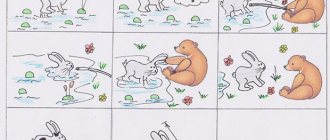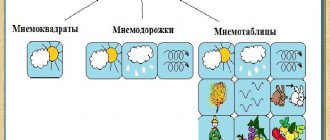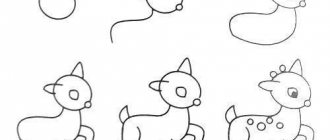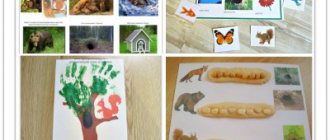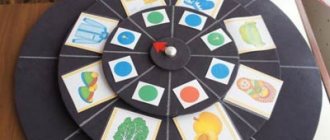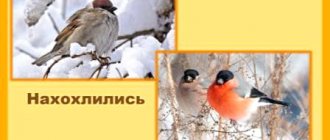Using mnemonic tables when compiling descriptive stories about animals and birds.
Using mnemonic tables when compiling descriptive stories about animals and birds.
Mnemonics – translated from Greek – “the art of memorization.” This is a system of methods and techniques that ensure successful memorization, preservation and reproduction of information, knowledge about the characteristics of natural objects, the world around us, effective memorization of the structure of a story, and, of course, the development of speech. Using mnemonics you can solve the following problems:
– development of coherent and dialogic speech in children;
– developing in children the ability, with the help of graphic analogy, as well as with the help of substitutes, to understand and tell familiar fairy tales and poems using a mnemonic table;
– teaching children correct sound pronunciation;
– development in children of mental activity, intelligence, observation, the ability to compare, and identify significant features;
– development of mental processes in children: thinking, attention, imagination, memory.
I want to share with you mnemonic tables for writing descriptive stories about wild and domestic animals, forest and domestic birds.
A sample of writing descriptive stories using an outline.
Scheme 1 Writing stories about pets
A cow is a domestic animal. She has a light brown skin, a large body, a round head and a tail with a panicle at the tip. The cow has hooves on its feet. She has horns on her head. The cow moos: "Moo-Moo." In summer she eats lush grass, and in autumn hay. A cow lives in a barn. A baby cow is called a calf. The cow gives man milk and meat.
Scheme 2 Writing stories about wild animals
A squirrel is a wild animal. She has a red coat, a small body and a bushy tail. The squirrel has tufted ears and claws on its paws. The squirrel eats nuts and collects supplies in a hollow for the winter. In winter, the squirrel feeds on tree bark and jumps from branch to branch. Baby squirrels are called squirrels. The squirrel is a pleasure to watch.
Scheme 3 Writing stories about poultry
A rooster is a domestic bird. It is big and colorful. It has two large wings, two paws, claws and spurs on its paws. The head has a crest, beak and eyes. The body is covered with feathers. He crows and loves to peck grain. He doesn't know how to fly, he can only fly up to something high. The rooster lives in the chicken coop with the chickens. Its chicks are called chicks. It gives feathers, down and meat to a person.
Scheme 4 Compiling stories about birds
This is a starling. Small bird. Its body is covered with black feathers and its head has a bright orange beak. The starling can sing beautifully and eats grains and insects. He lives close to people in the forest or park. The starling makes its nests from twigs, and people build birdhouses for starlings, which they hang on trees. In the spring, this bird gives birth to nestling chicks. This is a migratory bird. People believe that spring begins with the arrival of the starling.
MAGAZINE Preschooler.RF
Summary of an open lesson on speech development in the middle group: “Drafting a description of animals from a picture using a mnemonic table”
Compiled by teacher: Haleva E.A. Slavyansk-on-Kuban 2021 MUNICIPAL AUTONOMOUS PRE-SCHOOL EDUCATIONAL INSTITUTION kindergarten No. 4 “FAIRYTALE CITY”
Topic: Drawing up a description of animals from a picture using a mnemonic table.
Tasks:
- coherent speech: learn to write a description from a picture, name an object, its properties, characteristics, give it an assessment;
- vocabulary and grammar: learn to compose complex sentences;
- sound culture of speech: consolidate the correct pronunciation of the sound (u).
Materials: puppy toy. toy Parsley. (mnemonic table “Dog” ), box, brushes (tooth and clothes). treat for children.
Methods: verbal (guessing riddles, conversation, questions for children, visual (mnemonial table “Dog” ), physical education, outdoor game “Shaggy Dog” ,
Progress of the lesson.
1. Organizational moment: Psycho-gymnastics.
Good morning! A new day has come. I will smile at you, and you will smile at each other. And think how good it is that we are all here together today.. Now wish good morning to each other and the guests! Well done.
2. Whoever wants to talk must pronounce everything correctly and clearly, so that everyone can understand.
— Guys, Parsley came to visit us and he was very upset.
Parsley: Guys, I need your help, my faithful friend and I were playing hide and seek, and he got lost. And to find out who I'm talking about, guess the riddle:
This animal, seeing a cat, barks loudly at the window. Red with spots always spins around his feet... (Puppy)
Will you help him get back? (Children's answers)
And I have a hint. It's on the board.
look at the picture and describe the puppy
Educator: That's right, guys, a dog is a pet and it has an owner - a person. Now I invite you to remember the poem and play.
Physical education minute.
The cheerful dog barks loudly, the children pronounce words loudly and cheerfully,
with a joyful expression on his face.
“Woof, woof, woof” says to everyone. They pronounce the words loudly.
He gets bored without his owner, makes a sad expression on his face, says
spoken quietly, in a sad voice,
lowering your head and shoulders.
And whines quietly: Pronounced with intonation
“Oooh, ooh, ooh, ooh, ooh!” voice, turning his head then
to the right, then to the left.
Now the dog's owner has returned - They raise their heads and straighten their shoulders.
The dog seemed to smile. They smile.
He wags his tail, shows by moving his hand to the right -
Meets the owner! to the left, like a dog wagging its tail.
Educator: guys, look, Parsley didn’t come to us empty-handed. What is this? (children's answers) That's right - a box, but why does Parsley need a box? What's in the box? (Brushes). I suggest you tell Petrushka what these brushes are for. (children's answers)
Audio recording of a puppy's voice
Educator: Guys, you helped the puppy find his way. Look what he is like (children's answers).
Parsley: Thanks guys for your help. Do the puppy and I want to play a game with you? (Yes)
Pi "Shaggy Dog" .
Number of players: 10 people.
Instructions. A “dog” is chosen from among the players . He sits on the side. Other children slowly walk towards him, saying:
Here is a shaggy dog sitting with his nose buried in his paws.
Quietly, peacefully he sits, either dozing or sleeping.
Let's go up to him, wake him up and take a look.
What will happen?
The children quietly come up and clap their hands. The dog jumps up, growls, barks and catches the children. The caught player becomes the leading "dog" .
Educator: Result. Reflection
— What did you like about the lesson?
— Show your mood at the end of the lesson.
- Well done guys, you did a good job in class.
- Thank you very much.
| Next > |
Luponos Zoya Nikolaevna, teacher – speech therapist, MDOU kindergarten No. 1 “Alyonushka”
There is no area in human activity where speech is not used. It is needed everywhere. And especially at the learning stage. The success of his education depends on the quality of a child’s speech, so the main task of parents, educators and speech therapists is speech development. Pure, correct speech is one of the most important conditions for normal human mental development. With the help of speech and communication, the child easily and imperceptibly enters the world around him, learns a lot of new and interesting things, and can express his thoughts, desires, and demands. Unfortunately, these days children are becoming more and more speech impaired, which severely limit their communication with people around them. Inadequate speech development also affects the formation of non-speech mental processes: insufficient stability of attention is observed, verbal memory is reduced, and memorization productivity suffers. Corrective action should be based on the maximum use of the child’s capabilities. When teaching coherent speech, I use mnemonic techniques in my work. Mnemonics, or mnemo technique a system of various techniques that facilitate memorization and increase memory capacity by forming additional associations. Since preschoolers’ memory is involuntary: they remember facts, objects, and phenomena better, my teaching material is mnemonic tables—diagrams that contain certain information. Mastering the techniques of working with mnemonic tables significantly reduces training time and at the same time solves problems aimed at:
- development of basic mental processes - memory, attention, imaginative thinking;
- development of fine motor skills of the hands with partial or complete graphic reproduction of the text.
Using supporting drawings to teach memorizing poems captivates children and turns the activity into a game. The visual image that the child retains after listening, accompanied by viewing the drawings, allows him to remember the text much faster. To learn each poem, I develop and compile my own mnemonic table. First, I select supporting elements and fragments of the picture for the selected poem (preferably for each line), scan and, using a computer, process individual fragments to create a picture. And so, step by step, a mnemonic table is created. During the period of my work as a teacher-speech therapist, I created a series of mnemonic tables on poems on various topics: “Bread”, “Spring has come”, “Snow Woman”, “In the Forest”, “Defenders”, “My Mother” and many others. The next stage of working with the mnemonic table is an emotional, expressive reproduction of the text of the poem. Then I conduct vocabulary work on the work, a conversation on the meaning of what was read, and provide the opportunity for children to reproduce the text based on the drawings. The table-drawing hangs in a prominent place in the speech therapist’s office. Summary of a lesson on speech development in the preparatory group.
Topic: Life of wild animals in winter.
Correctional and educational goals: Consolidating ideas about wild animals, their appearance, lifestyle in winter, habits. Clarification, expansion and activation of the dictionary on the topic “Wild Animals” {animal, beast, bear, wolf, fox, squirrel, hedgehog, fur, skin, paw, den, hole; wild, predatory,). Teaching children to memorize a poem based on visual images (mnemonics). Improving the grammatical structure of speech (the use of nouns with the suffixes -onok-, -enok-, -am-, -yat. Corrective and developmental goals. Development of coherent speech, speech hearing, sense of rhyme, visual perception and attention, articulation, fine and gross motor skills , coordination of speech with movement. General speech skills, sound pronunciation, clarity of diction, intonation expressiveness. Correctional and educational goals. Formation of skills of cooperation, mutual understanding, goodwill, independence, initiative, responsibility. Fostering a love of reading fiction, poetry; respect for nature . Equipment. Computer, dry pool (beans), animal figures, plumes for breathing exercises, mnemonic table for the poem “Bear in the Forest”, pyramid of games, P. I. Tchaikovsky’s work “Seasons. Winter” (recorded). Preliminary work Learning the finger massage “Bear.” Reading M. Rapov’s fairy tale “The Hedgehog and the Squirrel”, V. Bianchi’s stories “Preparing for Winter”, “Adapted”.
LESSON PLAN
- Organizing time. Announcing the topic of the lesson. Creating an emotionally positive background.
- Development of fine motor skills, tactile sensitivity. Working in a dry pool (beans or peas) Search for planar figures.
- Writing a descriptive story. Description according to the diagram of the appearance and characteristics of wild animals (found in a dry pool).
Ask 3-4 children.
- Expressive reading of L. Kvitko’s poem “Bear in the Forest”
- Vocabulary work. Work on phrases and words: “Cold on the nose”, “The forest is almost completely stripped”, “The wind blows and sows”, “The evening has fallen”.
- Conversation on content.
- Repeated reading of the poem with the intention of memorizing.
- Independent reading of a poem by children (1-2 children).
- Physical exercise. Breathing exercises.
- Reading the poem to the other children. (Analysis and evaluation of the narration of the poem - after each reading by the child).
- The game is a labyrinth: “Help the bear get to the den”, “What animals are hiding?”
- Summary of the lesson.
Progress of the lesson
1. Organizational moment. The speech therapist organizes a greeting with the children, invites them to the office beans on the floor. It contains flat images of wild animals. Speech therapist. Go to the dry pool and put your hands in it and find one object at a time. Children complete the task. Speech therapist . What did you find? Children. We found figures of a squirrel, a bear, a fox, and a wolf. Speech therapist. Who are they? Children. These are wild animals. Speech therapist. Why are they called that? Children. They live in the forest, build their own housing and get food. Speech therapist. In today's lesson we will talk about wild animals, their life in winter, and I will also tell you a story that happened to one of the animals. 2. Main part Speech therapist. Guys, now you will write a story - descriptions of those animals whose figurines were taken out of the pool. First, you will say the name of your animal and then follow the scheme for describing the animal (Appendix 3). 1st child . A squirrel lives in a hollow tree. She has a long fluffy tail and tufted ears. By winter, the squirrel stores nuts, cones, and mushrooms. The squirrel does not scream, but clicks “tsk-tsk-tsk.” Her cub is a baby squirrel. 2nd child : The wolf is a predatory animal, lives in a den that it suits. Outwardly he looks like a dog, his fur is gray; he runs fast. Wolves hunt deer and large animals only in packs, and individually hunt small animals. A wolf cub is a wolf cub, baby wolf cubs look like puppies. 3rd child : The fox is a predatory animal, taller than a cat, but smaller than a dog, lives in a hole; There are claws on the paws, a long fluffy tail - the beauty and pride of the fox. Its body is covered with fluffy, brown or red fur. She has a very good instinct: she finds small animals by their tracks - a mouse, a hedgehog, a hare. 4th child: This is a bear, a wild animal. He lives in the forest and sleeps in a den in winter. It's big and brown. He has thick fur, a huge head, strong paws, and a small tail. His cubs are cubs. The bear can growl in a rough voice. The bear loves honey and raspberries, eats roots, and destroys anthills. The speech therapist praises each child for writing a story.
3. Reading the poem by L. Kvitko: “Bear in the Forest” Speech therapist: Guys, now, I’ll tell you a story that happened to a bear at the very beginning of winter, when he was preparing for hibernation. This is a poem , and it was written by the poet L. Kvitko. (Children sit on chairs, and the speech therapist demonstrates a presentation on L. Kvitko’s poem “Bear in the Forest.” The slide show is accompanied by an expressive, emotional reading of the poem by heart).
L. Kvitko “Bear in the Forest”
A bear walks through the forest, A bear wanders through the forest - Cold, cold on the nose - It’s very cold in the forest! The forest is almost completely stripped: There is no nest, no bird. Only the wind moans and groans, driving leaves along the paths, here and there. The bear stood on tiptoe, the bear stretched out its paws: “Wind, wind, don’t whistle!” A cloud of snow is coming! Powder all the trees, Powder all the bushes! The wind blows, blows, blows. It sows and sows with warm snow, Pooh and fluff - White all around. It immediately became quiet. The snow lies like a blanket. Evening fell to the ground... And where did the bear go? The worries are over - Sleeping in his den
4. Conversation based on content. Vocabulary work
Speech therapist. Children. Did you like the story about the bear?
Children. Yes.
Speech therapist. Tell me, guys, how do you understand “Cold on the nose”?
Children. – My mother says: the report is coming.
Speech therapist. That's right guys, this means it will soon be cold. What does it mean, “The forest is almost completely “stripped”?
Children. – Leaves are the clothes of the trees, and the wind blows the leaves and, as it were, “undresses” the trees.
Speech therapist. Right. Children, tell me, who was the bear talking to?
Children. - With the wind.
Speech therapist. What did the bear ask the wind?
Children. “No matter what he whistled, he covered everything with snow.”
Speech therapist. How did he ask?
Children. The bear stood on tiptoe, the bear stretched out its paws...
Speech therapist. Let's ask the bear for the wind: ( Choral repetition of the bear's request)
Children. - Wind, wind, don’t whistle! A cloud of snow is coming! Powder all the trees, Powder all the bushes!
Speech therapist. Guys, do you think the wind fulfilled the bear’s request?
Children. Having completed this, he began to slowly winnow and sow snow, and poured snow on it as a “blanket.”
Speech therapist. Well done, the wind fulfilled the bear’s request. Tell me, children, what does it mean that the snow lies like a “blanket”?
Children. It’s warm under the snow - and the ants and mice and roots don’t freeze.
Speech therapist: Well done! Sasha, you understand correctly. And who can say how evening fell to the ground?
Children . In winter, the days are short, the sun sets and it gets dark quickly. So they say that evening has fallen - it quickly got dark.
Speech therapist. Right! Guys, listen to this poem again.
5. Repeated telling of the poem with the intention of memorizing the poem. (Set up a mnemonic table) The speech therapist reads poems emotionally, expressively correlating each part with the picture of the mnemonic table, showing the sequence with a pointer.
6. Physical exercise. Children imitate:
- bear gait,
- standing while asking:
- the bear stood on tiptoe, - the bear stretched out its paws.
- Sleeps in a den.
7. Breathing exercises. To the music of P.I. Tchaikovsky "Seasons. Winter" children perform gymnastics exercises:
- Wind: - whistles,
- Storm
- It blows
- groans
8. Repeated telling of the poem with the intention of memorizing the poem. Speech therapist. Children, I will read the poem again. Try to remember the intonation, the pitch of the voice with which I pronounce the words of the poem in each picture. (The poem is read by a speech therapist based on the pictures of the mnemonic table).
9. Reading a poem by children. Children recite a poem based on mnemonic table pictures, a speech therapist helps children with different levels of speech development using techniques: prompting the first words of a line, difficult words, conjugate speech techniques, and more. 10. Analysis of children's reading of the poem. After each reading of a poem by children, an analysis of the story follows, involving children with a good memory.
11. Game. Guys, the bear left his supplies for you and me, but to get to them you need to complete tasks: first, find all the animals that are hidden in the picture (children are offered riddle pictures “What animals are hidden here?”) Appendix 4 . Second task: Game - labyrinth “Help the bear get to the den.” Appendix 3.
12.Result of the lesson. Speech therapist: Guys, what new did we learn in class? Children: - A story about a bear that happened to him at the beginning of winter. — we helped the bear get to the den and completed the correct drawing of the letters that we know. — found hidden animals in the picture and described them according to the diagram. — learned a new poem. Speech therapist: Well done guys, we managed to do and learn a lot today in our lesson. And most importantly, we learned L. Kvitko’s poem “The Bear in the Forest”; was it difficult to memorize it? Children: No. With tables we learn poetry quickly.
Annex 1
Appendix 2 Scheme for describing animals .
- What is it called? 2. Is this a wild or domestic animal? 3. Where does it live? What is the name of his home? 4. What size is it? 5. What color is it? 6. What is his body covered with? 7. What body parts does he have (their features)? 8. What are the baby animals called? 9. What sounds does the animal make? 10. What does it eat?
Appendix 3 Game - labyrinth
Appendix 4 Picture - a riddle What animals are hiding here?
Lesson on speech development in the middle group using mnemonics and model diagrams
A lesson on speech development in the middle group using mnemonics and model diagrams based on the fairy tale “Teremok”.
Program content:
- learn to name the distinctive features of wild animals (wolf, hare) using a mnemonic table;
- activate words and expressions in speech that allow you to begin and end a fairy tale;
- teach children to pronounce words clearly and distinctly, develop intonation expressiveness.
- continue to develop mental processes: memory, attention, visual and effective thinking;
- develop the ability to correlate sound symbols with images.
- cultivate a kind attitude towards animals;
- to accustom children to follow the basic rules of cultural behavior.
Visual material:
- mnemonic tables (for the fairy tale “Teremok”);
- characters from the tabletop theater based on the fairy tale “Teremok”
- caps of heroes based on the fairy tale “Teremok”.
Progress of the lesson.
Educator:
Hello guys!
Children:
Hello
Educator:
Guys, did guests come to us from the fairy tale “Teremok”?
Who is this? Children:
Bunny and wolf.
Educator:
Do you think the hare and the wolf are wild or domestic animals?
Children:
These are wild animals because they live in the forest.
Educator:
That's right, well done! How about I turn into a bunny and tell you about him using a table like this?
Storytelling using the mnemonic table “Hare”
Hare
- This is not a domestic animal, but a wild one. He lives in the forest. He has four legs. The body is covered with white wool in winter, and gray in summer. He has a small, short tail. There are two long ears on the head. The mother hare feeds her cubs with milk. When it grows up, the hare eats carrots, grass, cabbage, and in winter it eats tree bark or twigs.
Educator:
Did the bunny have an interesting story? And who will try to tell about the wolf, how angry and angry he is? Go... tell me about the wolf.
Storytelling using the mnemonic table “Wolf”
Wolf
wild animal. He lives in the forest. He has four legs. The body is covered with thick gray fur. The wolf has a long tail and very good hearing and scent. The she-wolf feeds her cubs with milk. The wolf is a predator, it has sharp teeth.
Educator:
Now let’s play a game called
“Mirror”,
I will show you the movements, and you must guess what animal I depicted and repeat the movements after me.
(Rooster, Bear, Sparrow, Ram) After the game, the children sit down in their places.
Educator:
Guys, remember what heroes are in the fairy tale “Teremok” and what nicknames each animal has: Mouse... (Norushka), Frog... (Wahakushka), Bunny... (Runner), Fox... (Sister), Top (Grey Barrel), Bear ( Toptyshka).
Educator:
Come on, you guys turn into our heroes from a fairy tale and tell us about yourself using the table.
I distribute hats upon request.
Educator:
A small mouse ran and said:
Mouse:
A small wild animal that sometimes lives next to humans. In nature, a mouse lives in a hole. She has short fur and a long tail. The mouse feeds on grain or beans.
Educator:
Thank you little mouse.
Educator:
A frog-frog jumped up and croaked.
Frog:
Lives in swamps or ponds. She has big eyes and a long tongue, with which she gets food. The frog feeds on mosquitoes and midges.
Educator:
Thank you frog!
Educator:
The little fox-sister came running, wagging her tail and saying.
Chanterelle:
This is a wild animal that lives in the forest and steppe. She has red fur and a very beautiful long tail. Mother feeds her cubs with milk. But the fox is a predator. It feeds on small animals and birds.
Educator:
Thank you little fox-sister.
Educator:
An awakened teddy bear wandered towards us and roared in his loud voice:
Bear:
Wild animal lives in the forest. In winter, the bear sleeps in a den. He has four paws, the skin of a bear is brown, brown in color. He is a predator and is very good at climbing trees. A mother bear feeds her cubs milk. He loves sweets, fish, meat, berries. The animal is omnivorous.
Educator:
Thank you, teddy bear!
Educator:
Well done guys, you know how to talk about yourself and show yourself.
Educator:
Now we will all play with the ball.
The game is called “Question and Answer”. (Stand in a circle, I throw the ball from the center and ask a question, and you throw the ball back to me and say the answer) Educator:
Where does the mouse live?
- In a hole,
where does the frog live?
- In the swamp.
The bunny lives -
Under a bush
.
Where does the fox live? - In the hole.
What is the name of the wolf's house?
- Lair.
What is the name of the bear's house?
- Den.
Which animal is a predator?
– Wolf, Fox, Bear
.
Educator:
What a great fellow you are, you told and answered everything correctly.
Who can tell me the name of the fairy tale in which all these animals lived together in one house? Children:
“Teremok”
Educator:
What words does the fairy tale “Teremok” begin with?
Children:
There is a tower in a field, it is neither low nor high... Then the teacher offers to play a fairy tale with the help of tabletop theater characters.
Methods of working with mnemonic tables in the senior group
-the model should display a generalized image of the object;
-reveal what is essential in the object;
- the idea for creating a model should be discussed with children so that it is understandable to them.
In parallel with this work, I use speech games, board and printed games that help children learn to classify objects, develop speech, visual perception, imaginative and logical thinking, attention, observation, interest in the world around them, and self-test skills. For individual work with children, I use the “Learning to Speak Correctly” computer program, developed on the basis of mnemonic techniques, and a series of computer presentations “Merry Kolobok School” for composing descriptive stories. I believe, and I think that you will agree, that model schemes can be used in other classes, in other types of activities (Productive activities, experimentation, theatrical activities, etc.) In connection with the introduction of new Federal state requirements for preschool education, rethinking by teachers has become relevant content and forms of work with children. Integration
– one of the most important and promising methodological directions in the development of modern education. Actually, “integration” means the combination of several academic subjects into one, in which scientific concepts are connected by a common meaning and teaching methods. Thus, integration is one of the most favorable forms of development of preschool children. It is known that the integrated approach meets one of the main requirements of preschool didactics:
A system of classes for speech development, as well as a system of artistic and aesthetic education
preschooler - two interrelated components of the process of educating and teaching children in kindergarten.
Each of them is at the same time the beginning and continuation of the other. My task is to connect in the consciousness and feelings of children the living world and the world of words, or rather, not even to connect, but to reveal their interdependence, which will most directly contribute to the harmonious development of the preschooler’s personality. This type of integration, as practice shows, allows preschoolers to increase the level of development of speech skills and skills acquired in the process of creative work. The presence of specialists of a narrow profile in preschool educational institutions makes it possible to include other integrated classes in the educational process. We use integrated classes on speech and musical development
of children, which have an effective impact on children.
Music, being a powerful tool that helps create a favorable emotional atmosphere, allows the child to feel free. Integrated music classes solve problems of improving phonemic hearing skills, automating sounds in a connected text, consolidating syllabic analysis skills, developing mobility of the vocal apparatus, coordination of movements, developing communication skills, consolidating the song and musical repertoire in a playful way. Solving the problems of speech and physical development
of preschool children, we organize integrated classes with a physical education instructor, where we combine physical and speech exercises. Some integrated physical education classes are developed in story form. The rhythm of speech, poems, sayings, and proverbs used in these classes contribute to the development of general motor skills, the correct tempo of speech and breathing rhythm are developed, speech hearing and speech memory develop. Such activities contribute to the formation of physical qualities in children, the development of coordination of movements and fine motor skills, the automation of sounds in play exercises, the pronunciation of which is most often impaired in preschool children, proper breathing, and the development of phonemic hearing. After all, it is known that the higher the child’s motor activity, the more intensively his speech develops, but the formation of movements also occurs with the participation of speech. Thus, the integration of all types of activities in the classroom and the integrated activities of specialists in a narrow profile, step by step, helps to overcome the complex process of forming correct, coherent speech in preschoolers.
